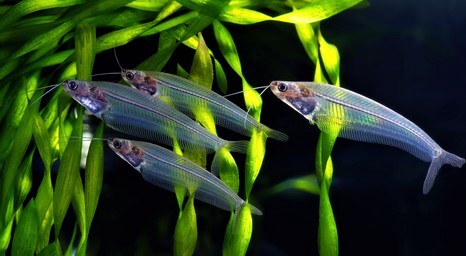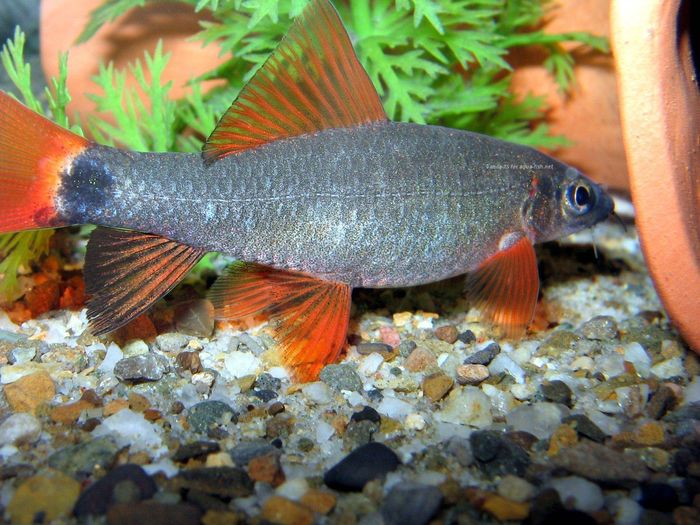Glass Catfish Are you fond of keeping fish in your aquarium? Or looking for some of the good collections? Well, you have to go through a lot of research to get information on a variety of fish available for your water tank.
In this article, we will discuss Ghost catfish in detail. This article is comprised of all the answers you are looking for.
Overview:
Glass Catfish, kryptopterus vitreolus (the scientific name), also known as Ghost catfish or Phantom catfish. They are medium-sized fishes with a subterminal mouth. Their body is transparent due to which their internal organs are visible. Yet, they have a strong and protective lower jaw.
According to their size, they are categorized into two types. The one with the smallest size, i.e. 2.5 inches is Kryptopterus vitreolus while the largest size, i.e. 6.5 inches, is Kryptopterus Bichirris.
This fish is considered to be a peace-loving spice that makes them ideal for keeping in your home aquarium. Although they may be tough for beginners, they soon settled down with other fishes as well.
They are active swimmers and love to swim in vegetation and plenty of areas of plants. They shouldn’t have kept them aggressive nature fish; otherwise, they will die out of stress or be hungry.
They are picky eaters but also eat small invertebrates and always prefer to stay acidic to alkaline water. They can even grow to 8 cm, and the life span can be 8-year years if they live with great care.

Quick Stats:
| CATEGORY | RATING |
| Scientific Name | Kryptopterus vitreolus |
| Common Names | Ghost Catfish, Glass Cat, phantom Fish |
| Origin | Far East |
| Family | Siluridae |
| Temperament / Behavior | Peaceful, Timid. |
| Color Form | Transparent |
| Diet | Omnivorous |
| Care Level | Moderate |
| Size | 2.5 – 3″ (8 cm) |
| pH | 6 – 7 |
| Temperature | 70 to 79°F (21 – 26°C) |
| Gender | Sexing is unknown |
| Lifespan | 7 to 8 Years |
| Breeding | It is difficult to spawn in the home aquarium. |
| Tank Size | 30 Gallons minimum |
| Tank Mates | Best kept with peaceful tank mates |
| Tank Set-Up | Planted Community |
| Compatibility | Community Tanks |
Origin
Glass catfish (which is also known as phantom fish) originated from the brackish waters of Thailand, even in Malaysia, Indonesia, Vietnam, and Cambodia. They prefer to stay in streams and rivers and flow with other fish inhabits in a school. They rarely go far away from their safety level.
Appearance
It is a common observation that the word glass or ghost indicates appearance. Most of the creatures with this word have a transparent or visible body.
While talking about the catfish, most organs are located near its head. Their transparent body allows you to see their organs and spine. You can even notice the heartbeat if you observed it.
As there are no pigments on their body, this catfish is more secure from its predators. But it’s also true that their “clear” bodies make them difficult to see even for a human being.
Although it may seem that the catfish have no dorsal fin, but, if you look a little bit closer, you can see a small fin behind the head of the fish.
Their Behavior
They are a great addition to your water tank because of their peaceful nature. You will find them quite energetic and free swimmers. Unlike other species, they usually swim around the middle of the tank. They also try to hide between plants located in your tank to avoid sunlight.
How to care for a Glass catfish?
They are very easy to keep because of their peaceful nature. They do not need extra care or attention, but a moderate level of care is enough for them. It is best to keep them in a school of 6 other spices.
Before introducing new members into the water tank, make sure to check they should not be sick before. The biggest challenge you can face while keeping ghost catfish is to make them alive for 7-8 years.
With consistent changes of water in a week, you can avoid some susceptible issues that most aquarium fish faces like ich, dropsy, fungus, or lice.
Possible Glass Catfish Diseases
The best challenges met while maintaining these fishes are the changes in climatic conditions. Keeping strict water parameters and maintaining them in good health is a difficult job. To lessen the health risks, ensure the location where you place your glass catfish remains clean and properly recycled.
Generally, the types of diseases they can be influenced by are:
- Ich: Here, you will discover grainy white spots on the surface of the skin, and they’ll continually be gasping for water.
- Fungus: There will be white or grey fungus growth on the outside of their skin.
- Lice: Generally, under this condition, the glass catfish become restless and will constantly try rubbing themselves on the surface, thereby hoping to remove the lice.
When you observe that some of your fishes are influenced by the kind of illnesses mentioned previously, separate them once.
Important care Tips:
Here, we have made a list of some care tips for a catfish in your home aquarium:
- Choose a water tank with the capacity of stock of at least six spices. The best is to have kept them with peace-loving mates. The species should not be more than 6 in number.
- The suitable temperature of the water in a water tank should be around 70 to 79°F (21 – 26°C).
- The least amount of water in the water tank should be around about 30 Gallons least or more. The less quantity of water can disturb the fishes, and they can refuse to eat.
- In the start, quarantine ghost fishes alone and avoid keeping them with other fishes. As there might be the possibility of any parasite or harmful diseases with them.
- It will be desirable and best if the natural environment (wild plants and streams) should be made stimulated. The ghost fishes love this kind of habitat, and they will be happy.
- This fish is very sensitive to brightness or lighter area; therefore, they like to hide beside the shaded parts of the water tank.
- Water should be renewed regularly. Otherwise, they pine away or become infected due to any issue caused by water impurities.
- In the case of food, they are picky eaters. Thus, frozen Mysis, daphnia, and brine shrimp are the perfect food for them. They will happily eat all.
What Do Glass Catfish Eat?
Being selective feeders and shy in nature, special care and attention are needed to feed them. Most of these catfishes eat zooplankton and other small worms. They are also known to eat baby guppies (small fish).
However, in the water tank, their food is replicated by a wider variety of food such as frozen or flake food. They should be treated by frozen brine shrimp, Daphnia, or Moina.
If you are looking for a catfish who is trained to eat flakes and freezer food, then local fish stores are ideal for that.
Now the question that arises is, how much food is required in a single day? Feeding a maximum of two times a day is ideal for them. Make sure to put a reasonable quantity of food in the water tank. Otherwise, it will spoil your tank and also can cause algae and bacteria in them.
Catfish are shy, which can sometimes cause doubt in them. When feeding the fish in the water tank, some species are very active, and that’s the reason, they eat the food first. But glass catfish remain unfed.
To make sure that all the fish have food, you must feed the active fish first and keep an eye on any doubt, making fish.
The ideal water tank conditions:
Well, these fish are sensitive to even a small fluctuation in temperature, pH, or other changes. Even slight changes in water parameters can cause the death of these fish.
Below are some points to follow. Keep in mind, that it varies from tank to tank since you know better about the species you put in a tank. If you don’t follow these points, then your fish is already at risk:
- The water temperature for an aquarium should be maintained at:
- 75- 80 degrees Fahrenheit,
- PH 6.5 to 7 and
- Have a very moderate water flow.
- The bigger the aquarium is, the more a catfish will feel safer and happier. So, the recommended quantity of water is at least 30 gallons per tank.
- Make sure the tank is well planted. They will help catfish to hide and also help to clean the water tank. You can add common plants like Java Fern, Java Moss, and Hornwort to the water tank.
- Don’t overcrowd the tank with more species as it can pop up different diseases and other health risks.
- You should control the level of ammonia and nitrates in a water tank as they are dangerous for glass catfish. For water purification, the water filtration system should be efficient and renewed
- You are in a problem if you set up your aquarium but couldn’t set up the filtration system. The bigger is the water tank, the bigger the filtration system will take care of your fish.
- Always check the level of ammonia, nitrate, pH level before introducing new fish into your aquarium.
Best tank mates for your Glass Catfish
Now the question is, can we keep catfish with other species in the same water tank?
They can keep with similar-minded mates like Swordtails, Celestial Pearl, Mollies, Corydoras, Kribensis, etc.
They are all peaceful fish that live together and don’t attack each other.
Keeping fish together is also important because they will lead to a strong social group; however, they shouldn’t keep with aggressive mates. In case, if you kept them with aggressive fish, they would die due to stress or non-compatibility.
Some of the aggressive fish include Oscars, Tiger Barbs, and Cichlids. Avoid keeping these mates as they can be dangerous for your class fish. They can even attack them or can also eat them.
You can add friendly fish with catfish and then gradually can add more fish once you see they are ready to accept more.
Glass Catfish Breeding
In their native habitat, they usually breed in times of heavy rainfall. But breeding in a water tank is still unknown and remains a mystery. But it is reported that some people are successful in breeding them in their aquariums.
For this, you must have at least one of each sex. Another challenging thing for you is to point out gender differences, i.e. male and female. Female fish have larger bellies and larger stomachs.
The best way for breeding is to create a natural environment in a tank. The temperature should be about 23 degrees Celsius and keep adding fresh water every day.
This lowest possible temperature and freshwater will help with breeding, while special attention is to be paid to the abundant supply of food to them. In this period, they need more energy to spawn.
If you don’t get success, then the female fish will lay their eyes on the aquarium plants which will hatch after 3-4 days. These hatched baby glass catfish will be capable of eating baby brine shrimp.
Glass Catfish Lifespan
The average glass catfish lifespan is between 7 and 8 years in optimal tank conditions. This really is enough amount of time that really lets you enjoy and bond with these fish.
Their lifespan could be shortened significantly if you don’t provide them with the proper tank conditions. Ensure to keep a compatible environment and follow the recommendations in this guide if you would like to make sure that they reside as long as possible.
Challenges of keeping Glass catfish
It is challenging for a beginner to keep catfish because of its sensitive and shy nature.
Following are some of the challenges you can face:
- You should create a natural environment like streams, plantations, and flowing water for them.
- Make sure to check all the parameters of the aquarium as they are prone to diseases.
- Change the water often so that the catfish must feel safe and happy.
- They are free swimmers, add some plants inside the aquarium.
- They feel more comfortable in the middle layer of the water tank. So, the temperature wouldn’t be less than 26-degree Fahrenheit.
- Don’t panic if they are found at the bottom of their new tank, and they will get up and swim later. They are doing so because of the little stress of a new home.
- The best way is to put the food near a current to feed them food.
Some cool facts about Glass catfish
Here is a list of some cool facts about Ghost catfish which you will shock to learn:
- Some of the catfish can even detect electromagnetic waves. This is the reason scientists are trying to understand how this thing can benefit patients with Parkinson’s and Epilepsy.
- The Ghost catfish are also known as the Glass catfish, X-ray fish because of its transparent body.
- Their transparent body helps them to save from predators.
- Another cool fact is that they will show no appetite when they are alone. But you will find them much more active and happier with their similar-minded species.
- This delicate catfish can live up to 7 to 8 years with proper care and attention.
Conclusion
FAQ’S Related to Glass Catfish
On account of their nature, having approximately 6 fish in the 30-gallon tank is the most excellent choice. This usually means having 1 Glass Catfish for every 5 gallons. You have to give them lots of space since if not, health dangers can arise. Diseases and other expansion defects can pop up in case you overcrowd your tank.
Due to their calm temperament, they should always be kept at five; they may be kept with other fish species of similar size and cool character. Glass catfish are highly sensitive to water quality fluctuations and pH fluctuations.
Glass catfish are great tank mates for bettas. However, based on the temperament of your betta, the opposite could be true. Therefore, you should only add glass catfish to a Betta tank if you know that your Betta has a peaceful temperament.
Even though it’s not guaranteed, glass cats may additionally take flakes. In general, you must start them out on a meaty diet of live, frozen, or freeze-dried foods and then constantly work in flake feedings. Always use high-quality flake food for transparent cats.



